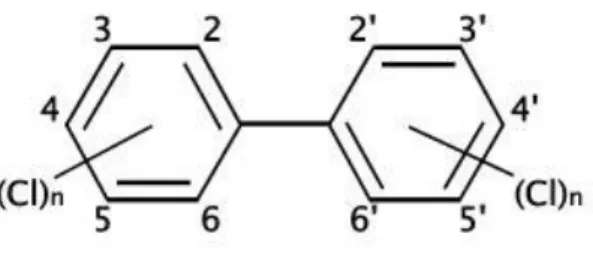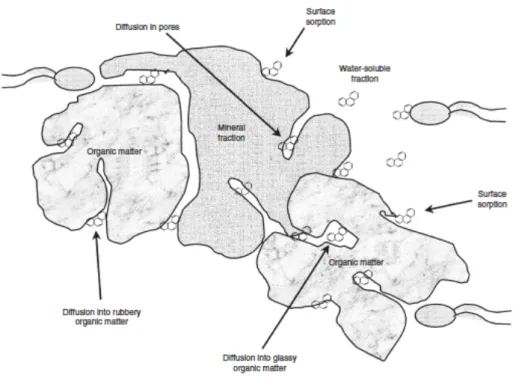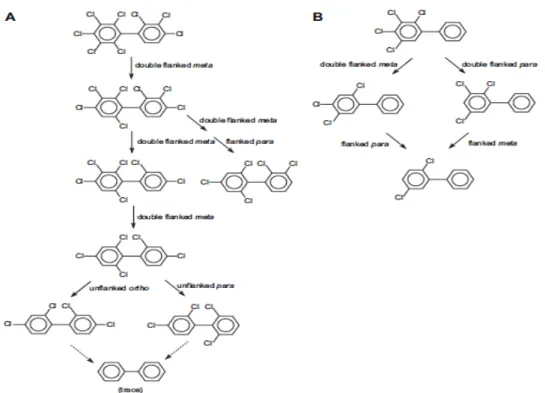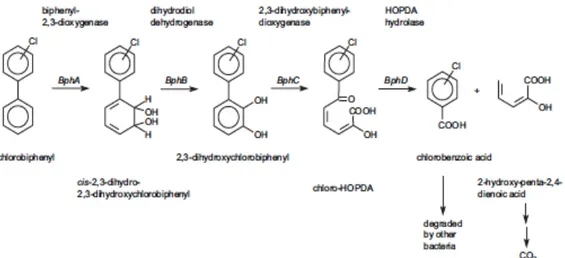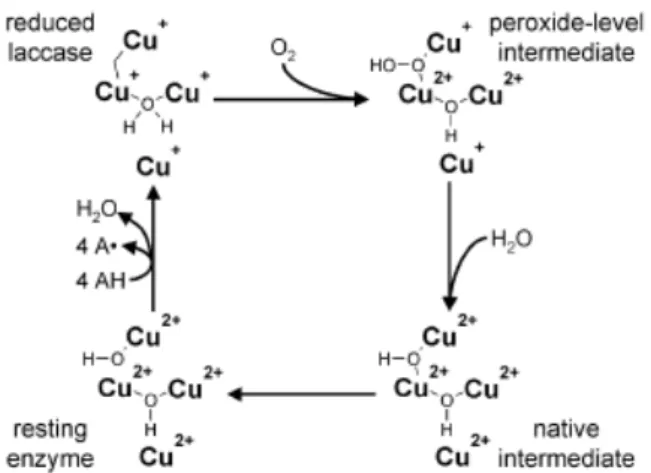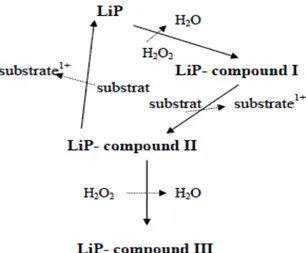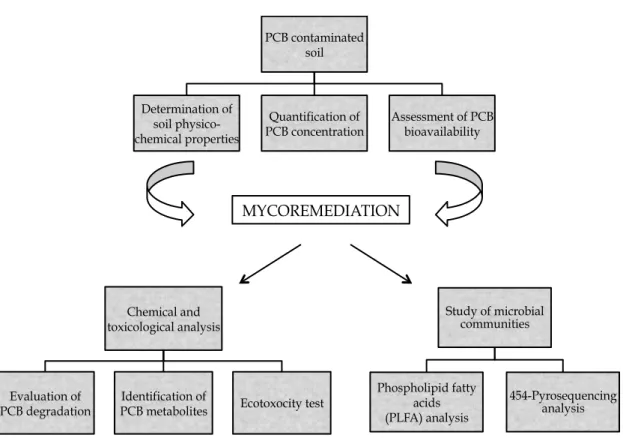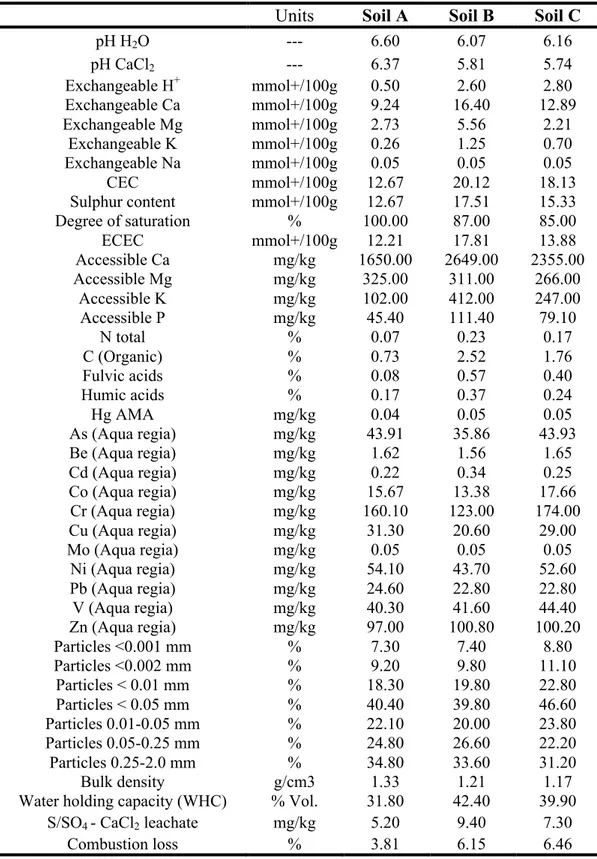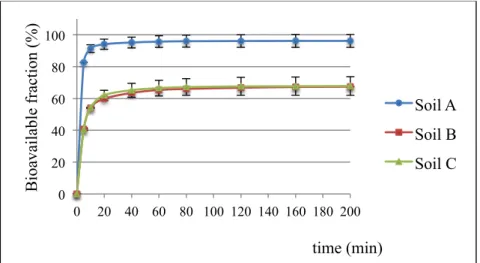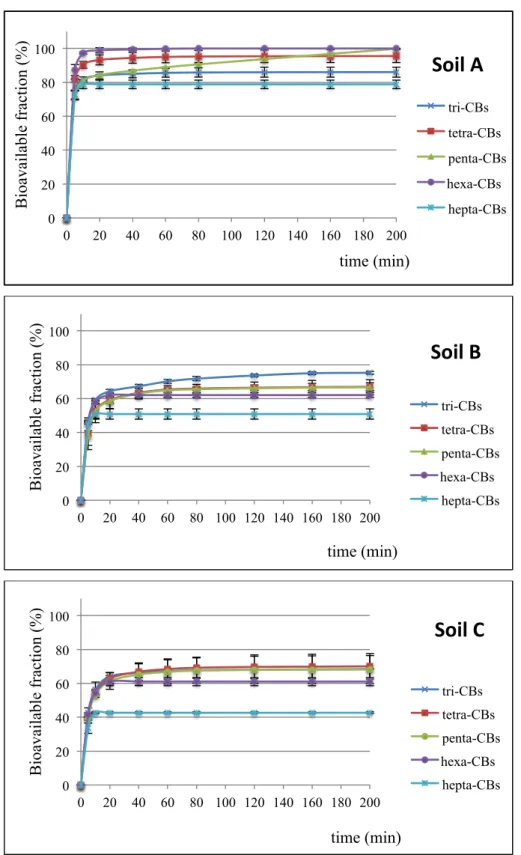!!!!!!!!!!!!!!!!!!!!!!!!!!!!!!!!!!!!!!!!!!!!!!!!!!!!!
!
!
Title
Bioremediation of persistent aromatic pollutants
Titolo
Biorisanamento di contaminanti aromatici persistenti
(BIO/19)
PhD in “Environmental Sciences” (Cycle XXVI)
MSc. Tatiana Stella!
Tutor and coordinator: Prof. Maurizio Petruccioli
Univesità degli Studi della Tuscia (Viterbo)
Tutor: doc. RNDr. Tomáš Cajthaml, Ph.D.
Přírodovědecká fakulta, Univerzita Karlova v Praze
Viterbo 2014
Univerzita Karlova v Praze
Přírodovědecká fakulta
Environmentální vědy
Università degli Studi della Tuscia
Dipartimento per l’Innovazione nei
sistemi Biologici, Agroalimentari e
!
!!!!!!!!!!!!!!!!!!!!!!!!!!!!!!!!!!!!!!!!!!!!!!!!!!!!!
!
!
Title
Bioremediation of persistent aromatic pollutants
Název
Bioremediace persistentních aromatických polutantů
Disertační práce
Mgr. Tatiana Stella!
Školitel: Prof. Maurizio Petruccioli
Univesità degli Studi della Tuscia (Viterbo)
Školitel: doc. RNDr. Tomáš Cajthaml, Ph.D.
Přírodovědecká fakulta, Univerzita Karlova v Praze
Praha 2014
Univerzita Karlova v Praze
Přírodovědecká fakulta
Environmentální vědy
Università degli Studi della Tuscia
Dipartimento per l’Innovazione nei
sistemi Biologici, Agroalimentari e
Prohlášení:
Prohlašuji, že jsem závěrečnou práci zpracoval/a samostatně a že jsem uvedl/a všechny použité informační zdroje a literaturu. Tato práce ani její podstatná část nebyla předložena k získání jiného nebo stejného akademického titulu.
V Praze, 07.05.2014
Acknowledgements
First and foremost I would like to acknowledge my tutors Prof. Maurizio Petruccioli and Assoc. Prof. Tomas Cajthaml, Ph.D for their scientific support, strong encouragement and friendly attitude over the period of my Ph.D.
I would like to express my deep gratitude to my supervisor Alessandro D’Annibale, Ph.D for his insightful advices and the stimulating discussions we had over these years.
My sincere thank goes also to all the members of the laboratory of “Environmental Biotechnology” at the Academy of Science of Czech Republic and the laboratory of “Microbiology and Environmental Biotechnology” at Tuscia University in Viterbo: Stefano Monika, Eva, Zdena, Jana, Alena, Jarka, Brano, Kata, Amelie, Martin and Lenka.
I would like to acknowledge also RNDr. Petr Baldrian, Ph.D and his research group for their contribution to my professional growth and scientific knowledge.
A special thank goes to my “personal” scientific advisor Stefano for the great enthusiasm and the extraordinary patience shown to strongly motivate and support me during my PhD work.
My deepest gratitude goes to my extraordinary family to have been constantly present even though so distant for all these years.
Last but not least, I would like to thank my friends Guglielmo, Fabiana, Simona, Lorena, Samantha, Giorgia, Irene, Salvador, Ruben, Paula and Lucka.
This Ph.D work was supported by grant Competence Center TE01020218 of the Czech Technology Agency, by grant no. 13-28283S of the Czech Science Foundation and by the Ministry of Education, Youth and Sports of the Czech Republic projects CZ.1.07/2.3.00/20.0055 and CZ.1.07/2.3.00/30.0003.
Abbreviations
16S rDNA 16S ribosomal RNA
ABTS 2,2´-azinobis (3-ethylthiazoline-6-sulfonate) APEG alkaline metal hydroxide/polyethylene glycol ASE accelerated solvent extraction
BCD base-catalysed decomposition
Bph bacterial biphenyl genes
BSA bovine serum album
BTEX benzene, toluene, ethylbenzene, xylenes CBAs chlorobenzoic acids
CEC cation exchange capacity CO carbon monoxide
CYP420 cytochrome P420 monooxygenase system CYP450 cytochrome P450 monooxygenase system DDT dichlorodiphenyltrichloroethane
DMSO dimethyl sulfoxide DTT dithiotreitol
EDTA ethylenediaminetetraacetic acid FPLC fast protein liquid chromatography GC-MS gas chromatography-mass spectrometry HBT 1-hydroxybenzotriazole
HKC heat killed control
HOPDA 2-hydroxy-6-oxo-6-(chloro) phenylhexa-2,4-dienoic acid ITS internal transcribed spacer
Koc organic carbon partition coefficient
KPEGTM potassium metal hydroxide/ polyethylene glycol Lac laccase
LiP lignin peroxidase MEA malt extract agar
MNA monitored natural attenuation MnP manganese-dependent peroxidase MS-MS tandem mass spectrometry
OC organic carbon
OH-PCBs hydroxylated polychlorinated biphenyls OTU operational taxonomic unit
PAHs polycyclic aromatic hydrocarbons PB piperonyl butoxide
PCA principal component analysis PCBs polychlorinated biphenyls
PCDDs polychlorinated dibenzo-p-dioxins PCDFs polychlorinated dibenzofurans PCR polymerase chain reaction PLFA phospholipid fatty acids PMSF phenylmethylsulfonyl fluoride
QIIME quantitative insights into microbial ecology
RP-HPLC reversed-phase high performance liquid chromatography SFE supercritical fluid extraction
VP versatile peroxidase WHC water holding capacity
Abstract
The remediation of persistent chlorinated aromatic compounds has become a priority of great relevance due to the teratogenic, carcinogenic and endocrine-disrupting properties of these xenobiotics. The use of biological methodologies for the clean-up of contaminated sites, collectively referred to as “bioremediation”, has been gaining an increasing interest in recent years because it represents an effective, cost-competitive and environmentally friendly alternative to the physico-chemical and thermal treatments. In this respect, “white rot” fungi, an ecological subgroup of filamentous fungi, display features that make them excellent candidates to design an effective remediation technology (“mycoremediation”). In spite of this, fungi have not been widely exploited for their metabolic capabilities and the mechanism by which they are able to degrade the aforementioned pollutants has not been fully elucidated yet.
Within this frame, the present Ph.D thesis was aimed at:
i) assessing the efficiency of different mycoremediation strategies for the clean-up of a
polychlorinated biphenyl (PCBs)-contaminated soil;
ii) understanding the fungal degradation pathways of polychlorinated biphenyls and their
major metabolites, namely chlorobenzoic acids (CBAs) and hydroxylated polychlorinated biphenyls (OH-PCBs).
i) The combination of chemical, toxicological and molecular biology techniques provided a
comprehensive evaluatation of the technical feasibility of selected remedial strategies. Physico-chemical properties (pH, soil texture, soil organic matter content, ect.) as well as the pollutant bioavailability of three different PCB-contaminated soil samples from a dumpsite (bulk soil, topsoil and rhizosphere soil) were assessed before undergoing both bioaugmentation (either with the white rot fungus Pleurotus ostreatus or Irpex lacteus) and biostimulation (addition of a lignocellulosic substrate) treatment. The inoculation of P.
ostreatus in the rhizosphere soil was the most effective treatment in terms of PCB degradation
and detoxification. The involvement of both intracellular and extracellular fungal enzymes in the biotransformation of PCBs was demonstrated by the identification of several PCB degradation intermediates (i.e. chlorobenzoates, chlorobenzaldehydes, chlorocresols, hydroxylated and methoxylated PCBs). Furthermore, new insights into the microbial community structure, diversity and dynamics throughout the bioremediation processes were gained with the combination of two culture-indipendent techniques: phospholipid fatty acids
(PLFA) and 454-pyrosequencing analyses. PLFA analysis showed that either the introduction of allochthonous fungi or the addition of non-inoculated lignocellulosic substrate stimulated the growth of the resident bacterial populations, while the highest fungal concentration was achieved in P. ostreatus-topsoil microcosms in the incubation middle phase. Metagenomic analysis of bacterial community revealed that Firmicutes relative abundance increased in
Pleurotus ostreatus-bulk and -rhizosphere soil microcosms; on the other hand, in
I.lacteus-augmented microcosms, an initial increase of Proteobacteria was observed whereas
Bacteroidetes became dominant at the end of incubation. Analysing the fungal community
structure in bioaugmented soils, P.ostreatus showed a higher ability than I. lacteus to compete with the autochthonous soil mycobiota. Indeed, P.ostreatus sequences accounted to more than 90% of the total fungal amplicons along the whole incubation period, thus proving the outstanding capability of this fungus to efficiently grow in PCB-contaminated soils under non-sterile conditions. By contrast, the large majority of fungal sequences in biostimulated microcosms belonged to the phyla Ascomycota and Zygomycota, with the exception of the topsoil where members of the phylum Basidiomycota became predominant in the later phase of the incubation
ii) Microsomal fractions rich in cytochrome P450 monooxygenase (CYP450) activities were
isolated from the white rot fungi Lentinus tigrinus and Pleurotus ostreatus to evaluate their involvement in the biotransformation of CBAs and PCBs, respectively. In both cases, CYP450 was firstly detected by carbon monoxide-binding spectrum, and then used to perform
in vitro degradation tests with selected compounds. Such intracellular enzymatic system was
able to degrade either a mixture of CBAs (L. tigrinus) or PCBs (P. ostreatus). Specifically, the identification of a hydroxylated CBA confirmed the pivotal role of CYP450 in the initial transformation of CBAs. Moreover, a semi-purified laccase obtained from P. ostreatus was capable of degrading mono- and dichlorinated hydroxylated biphenyls, at different extent, either under mediated or non-mediated conditions. The chemical structure of chlorinated organic pollutants, namely the number and position of substituents, was the main factor affecting the extent of degradation by both fungal intracellular and extracellular enzymes.
Keywords: “white rot” fungi, mycoremediation, polychlorinated biphenyls, ligninolytic enzymes, cytochrome P450 monooxygenases system, 454-pyrosequencing.
Riassunto
Il risanamento di matrici ambientali contaminate da composti organoclorurati recalcitranti è divenuto una questione di fondamentale importanza a causa delle proprietà teratogeniche e cancerogene di tali composti, nonchè per le loro caratteristiche di interferenti endocrini. A tal proposito, le tecniche di risanamento biologico (biorisanamento) stanno riscuotendo un crescente interesse negli ultimi anni rispetto ai più convenzionali metodi chimico-fisici in virtù della loro comprovata sostenibilità ambientale ed economica. In particolare, i “funghi del marciume bianco”, un sottogruppo ecologico dei funghi filamentosi specializzato nella degradazione della lignina, presentano delle caratteristiche interessanti, tali da renderli degli ottimi candidati per la messa a punto di tecniche di biorisanamento (micorisanamento). Tuttavia, le straordinarie capacità metaboliche di questi funghi non sono ancora state sfruttate appieno per fini di recupero ambientale ed i meccanismi attraverso i quali essi degradano i suddetti contaminanti clorurati non sono stati chiariti in dettaglio.
Detto questo, la presente tesi di dottorato ha avuto come scopo:
i) la valutazione dell’efficacia di diverse tecniche di micorisanamento nel trattamento di suoli
contaminati da policlorobifenili (PCB);
ii) l’analisi dei meccanismi attraverso i quali i funghi del marciume bianco degradano (PCB) ed i loro principali metaboliti, acidi clorobenzoici (CBA) e policlorobifenili idrossilati (OH-PCB).
i) La fattibilità tecnica delle strategie di risanamento oggetto di studio è stata valutata
mediante una combinazione di analisi chimiche, tossicologiche e biomolecolari. In una fase preliminare alle prove di risanamento sono state esaminate le proprietà chimico-fisiche (pH, tessitura, sostanza organica ecc.) di tre diversi campioni di suolo (suolo non di rizosfera, suolo superficiale e suolo di rizosfera) provenienti da un sito di stoccaggio ed inoltre, è stata determinata la biodisponibilità dei contaminanti in essi contenuti. Successivamente, tali matrici sono state sottoposte sia a trattamenti di bioaumento fungino (con Pleurotus ostreatus o Irpex lacteus, due noti agenti della carie bianca del legno) che di biostimolazione (attraverso l’aggiunta di ammendanti lignocellulosici). L’apporto di P. ostreatus nel suolo di rizosfera è risultato il trattamento più efficace in termini di rimozione dei PCB e detossificazione. In generale, l’identificazione di diversi prodotti di degradazione dei PCB (acidi clorobenzoici, clorobenzaldeidi, cresoli clorurati, idrossi- e metossi-PCB) ha dimostrato il coinvolgimento di diversi sistemi enzimatici fungini, intracellulari ed extracellulari, nella biotrasformazione dei suddetti composti. Inoltre, l’utilizzo di due approcci coltura-indipendenti, ovvero l’analisi
degli acidi grassi di membrana (PLFA) ed il pirosequenziamento (sequenziamento 454), ha permesso di ottenere informazioni circa la struttura e l’evoluzione delle comunità microbiche durante le prove di risanamento. L’analisi PLFA ha mostrato che l’aggiunta di inoculi fungini o di semplice substrato lignocellulosico ha avuto un effetto stimolante sulla crescita della popolazione batterica del suolo e che la più alta densità fungina è stata riscontrata nel suolo superficiale bioaumentato con P. ostreatus a metà del periodo di incubazione stabilito. L’analisi della comunità batterica effettuata tramite metagenomica ha rivelato che il bioaumento di P. ostreatus sia nel suolo non di rizosfera che di rizosfera ha indotto un aumento dell’abbondanza relativa del phylum Firmicutes, mentre nei microcosmi inoculati con I. lacteus, i phyla dominanti erano Proteobacteria e Bacteroidetes, rispettivamente nelle fasi iniziali e finali del trattamento. Dall’analisi della comunità fungina, P. ostreatus è risultato migliore di I. lacteus nel competere con la microflora autoctona dei suoli. In particolare, P. ostreatus ha rappresentato, per l’intero periodo d’incubazione, oltre il 90% delle sequenze fungine nei tre i suoli in cui è stato introdotto, dimostrando di saper crescere in suoli contaminati da PCB in condizioni di non sterilità. Di contro, nei suoli biostimolati l’aggiunta di ammendante in forma sterile ha favorito la crescita di funghi appartenenti ai phyla Ascomycota e Zygomycota, con la sola eccezione del suolo superficiale in cui il phylum
Basidiomycota è diventato predominante nella seconda metà del trattamento.
ii) Al fine di valutare il coinvolgimento del sistema enzimatico citocromo P450
monossigenasi (CYP450) nella degradazione di CBA e PCB, frazioni microsomali ricche di attività CYP450 sono state isolate dai funghi Lentinus tigrinus e Pleurotus ostreatus. L’attività del CYP450 è stata quantificata spettrofotometricamente al fine di effettuare successivamente delle prove di degradazione in vitro con i composti selezionati. Tale sistema enzimatico intracellulare è stato capace di degradare sia una miscela di CBA (L. tigrinus) che di PCB (P. ostreatus). In particolare, l’identificazione di una forma idrossilata di un acido clorobenzoico ha confermato il diretto coinvolgimento del CYP450 nelle fasi iniziali di trasformazione dei CBA. Inoltre, la degradazione di forme idrossilate di bifenili mono- e di-clorurati da parte di una laccasi semipurificata, estratta da P. ostreatus, è stata dimostrata sia in presenza che in assenza di uno specifico mediatore. La struttura chimica dei suddetti contaminanti ha rappresentato il principale fattore determinante le capacità degradative degli enzimi fungini sia intracellulari che extracellulari.
Parole chiave: funghi del marciume bianco, micorisanamento, bifenili policlorurati, enzimi ligninolitici, citocromo P450 monossigenasi, 454-pirosequenziamento.
Abstrakt
Remediace persistentních chlorovaných aromatických sloučenin se stala prioritou vzhledem k teratogenním, karcinogenním a endokrinním účinkům těchto xenobiotik. V současné době si získává při sanacích znečištěných lokalit stále větší pozornost použití biologických remediačních technologií, souhrnně označovaných jako bioremediace. Představují efektivní, cenově konkurenceschopnou alternativu šetrnou k životnímu prostředí ve srovnání s fyzikálně-chemickými dekontaminačními postupy. Jako vhodný kandidát pro vytvoření remediační technologie se jeví skupina ligninolytických basidiomycetních hub tzv. houby bílé hniloby (mykoremediace). Doposud však nebyly pro své metabolické schopnosti široce využívány a mechanismus, jakým jsou schopny degradovat výše zmíněné polutanty, není rovněž plně prozkoumán.
Tato disertační práce byla zaměřena na:
i) zhodnocení účinnosti různých mykoremediačních strategií při odstraňování
polychlorovaných bifenylů (PCB) z kontaminované půdy,
ii) porozumění mechanismu specifických houbových degradačních drah PCB a jejich
hlavních metabolitů (CBA, chlorbenzoové kyseliny a OH-PCB, hydroxylované polychlorované bifenyly).
i) K vyhodnocení technické proveditelnosti vybraných remediačních strategií byla použita
kombinace chemických, toxikologických a molekulárně-biologických technologií. Před uskutečněním samotné bioaugmentace (založenou na aplikaci ligninolytických hub Pleurotus
ostreatus nebo Irpex lacteus) a biostimulace (přídavek lignocelulosového substrátu) byly u tří
různých vzorků půdních horizontů (A – humusový horizont, B – půdní horizont, C – matečná hornina) ze skládky zeminy kontaminované PCB sloučeninami stanoveny fyzikálně-chemické vlastnosti (pH, struktura půdy, obsah organických látek atd.) a rovněž biodostupnost kontaminantu. Z hlediska schopnosti degradace a detoxifikace PCB byla nejúspěšnější strategie aplikující druh P. ostreatus do druhého typu půdního horizontu. Identifikace několika meziproduktů při odbourávání PCB (jako například chlorbenzoáty, chlorbenzaldehydy, chlorokresoly, hydroxylované a methoxylované PCB) demonstrovala zapojení jak intracelulárních, tak extracelulárních houbových enzymů při biotransformaci PCB. Kromě toho, za použití kombinace kultivačně nezávislých metod analýzy fosfolipidových mastných kyselin (PLFA) a 454-pyrosekvenace byl získán nový pohled na strukturu mikrobiální komunity, její divergenci a dynamiku v průběhu celého
bioremediačního procesu. Pomocí PLFA metody se ukázalo, že buď zavedení alochtonních hub nebo přidání lignocelulosového substrátu podporovalo růst bakteriálních populací, zatímco největší houbové koncentrace bylo dosaženo u druhu P. ostreatus a prvního typu půdního horizontu, ve střední fázi inkubace. Metagenomická analýza bakteriálního společenstva odhalila, že relativní výskyt kmene Firmicutes vzrostl při aplikaci druhu P.
ostreatus v prostředí druhého a třetího půdního horizontu. Naproti tomu při aplikaci druhu I. lacteus byl pozorován zvýšený výskyt kmene Proteobacteria v počáteční fázi inkubace a
dominantní nástup kmene Bacteroidetes na konci inkubace. Co se týče analýzy houbového společenství, P. ostreatus vykazoval vyšší schopnost konkurovat původnímu houbovému osazení než I. lacteus. Ve skutečnosti více než 90 % analyzovaných sekvencí bylo identifikováno jako P. ostreatus po celou dobu inkubace, což dokazuje vynikající schopnost tohoto druhu účinně růst v půdách kontaminovaných PCB za nesterilních podmínek. Naproti tomu velká většina analyzovaných sekvencí v případě biostimulace patřila ke kmenům
Ascomycota a Zygomycota, s výjimkou pozdní inkubační fáze u prvního typu půdního
horizontu, kde dominoval kmen Basidiomycota.
ii) Mikrosomální frakce bohaté na cytochrom P450 monooxygenasu (CYP450) byly
izolovány u hub bílé hniloby Lentinus tigrinus a Pleurotus ostreatus za účelem posouzení jejich zapojení do biotransformace CBA a PCB. V obou případech, byla nejdříve CYP450 detekována pomocí spektra v komplexu s oxidem uhelnatým, a poté byla použita na in vitro degradační testy s vybranými sloučeninami. Takovýto intracelulární enzymatický systém byl schopný degradovat buď CBA (L. tigrinus), nebo PCB (P. ostreatus). Konkrétně, klíčová úloha CYP450 v počáteční fázi transformace CBA byla potvrzena identifikováním hydroxylovaných CBA. Kromě toho nedokonale přečištěná lakasa získaná z druhu P.
ostreatus byla schopna degradovat mono- a dichlorované hydroxylované bifenyly, v různé
míře, buď za optimalizovaných, nebo neoptimalizovaných podmínek. Hlavním faktorem, který ovlivňoval rozsah degradace jak intracelulárních, tak extracelulárních houbových enzymů, byla chemická struktura chlorovaných organických kontaminant, jako je počet a poloha substituentů.
Klíčová slova: houby bílé hniloby, mykoremediace, polychlorované bifenyly, ligninolytické enzymy, cytochrom P450 monoxygenasový system, 454-pyrosekvenace.
CHAPTER 1
GENERAL INTRODUCTION……… 1
1.0 Preface……….. 2
1.1 Polychlorinated biphenyls……… 3
1.2 Environmental fate of PCBs ... 4
1.3 PCBs in the soil environment ... 7
1.4 PCB toxicity ... 9
1.5 Remediation technologies ... 11
1.5.1 Remediation of PCBs ... 12
1.5.1.1 Thermal and physico-chemical treatments of PCBs ... 13
1.5.1.1.1 Incineration ... 13 1.5.1.1.2 Thermal desorption ... 13 1.5.1.1.3 Solvent extraction ... 14 1.5.1.1.4 Chemical dehalogenation ... 14 1.5.1.1.5 Solidification/Stabilization ... 14 1.6 Bioremediation ... 15 1.6.1 Bioremediation of PCBs ... 17
1.6.1.1 Anaerobic bacterial degradation of PCBs ... 17
1.6.1.2 Aerobic bacterial degradation of PCBs ... 19
1.6.1.3 Sequential anaerobic-aerobic bioremediation of PCBs ... 22
1.6.2 Phytoremediation ... 23
1.6.2.1 Phytoremediation of PCBs ... 24
1.6.3 Mycoremediation and “white rot” fungi ... 26
1.6.3.1. “White rot” fungi ligninolytic enzymes ... 27
1.6.3.1.1 Laccase ... 28
1.6.3.1.2 Manganese peroxidase ... 29
1.6.3.1.3 Lignin peroxidase ... 30
1.6.3.1.4 Versatile peroxidase ... 31
1.6.3.2 Production patterns and cooperation of ligninolytic enzymes ... 32
CHAPTER 2
MYCOREMEDIATION OF A LONG TERM PCB-CONTAMINATED SOIL………. 34
2.1 Introduction ... 35
2.2 Materials and methods ... 37
2.2.1 Soil samples collection ... 37
2.2.2 Physico-chemical analyses of soil samples ... 37
2.2.3 Chemical analysis of contaminants ... 37
2.2.4 Bioavailability of PCBs ... 38
2.2.5 Microorganisms and inoculum preparation ... 39
2.2.6 Microcosms preparation ... 39
2.2.7 Ecotoxicology test with Vibrio fischerii (luminescent bacteria test) ... 40
2.2.8 Extraction and analysis of phospholipid fatty acids ... 40
2.2.9 DNA extraction, amplification and pyrosequencing analysis ... 40
2.2.10 Pyrosequencing data analysis ... 41
2.2.11 Statistical analysis ... 41
2.3 Results and Dicussion ... 42
2.3.1 Physico-chemical characterization of soil samples ... 42
2.3.2 Contaminant characterization of soil samples ... 44
2.3.3 Bioavailability of PCBs ... 48
2.3.4 Degradation of PCBs ... 51
2.3.5 Vibrio fischerii toxicity assay ... 53
2.3.6 Detection and identification of PCB degradation intermediates ... 54
2.3.7 Phospholipid fatty acids analysis ... 58
2.3.8 Pyrosequencing ... 60
CHAPTER 3
FUNGAL DEGRADATION MECHANISMS OF CHLORINATED ORGANIC
POLLUTANTS………... 70
3.1 Introduction ... 71
3.2 Materials and methods ... 73
3.2.1 Extraction of fungal microsomal fraction ... 73
3.2.2 Detection and quantification of cytochrome P450 in the microsomal fraction ... 73
3.2.3 In vitro PCB and CBA degradation test with cytochrome P450 ... 73
3.2.4 Semipurification of Pleurotus ostreatus laccase ... 74
3.2.5 Enzymatic assays ... 75
3.2.6 In vitro hydroxy-PCB degradation test with Lac and MnP ... 75
3.2.7 Samples preparation and analytical methods ... 76
3.3 Results and Discussion ... 76
3.3.1 Detection of cytochrome P450 ... 76
3.3.2 In vitro degradation of CBAs by Lentinus tigrinus microsomal fraction ... 78
3.3.3 In vitro degradation of PCBs by Pleurotus ostreatus microsomal fraction ... 82
3.3.4 In vitro degradation of hydroxy-PCBs by Pleurotus ostreatus semi-purified laccase 85 3.4 Conclusions ... 89 CHAPTER 4 CONCLUDING REMARKS ……… 90 CHAPTER 5 BIBLIOGRAPHY……….. 93 CHAPTER 6 PUBLICATIONS, CONFERENCES, SEMINARS and COURSES………... 115
CHAPTER 1
GENERAL INTRODUCTION
! !
1.0 Preface
The intensive industrial processes and agricultural practices have been leading to the deliberate or accidental release of potentially toxic chemicals into the environment during the last decades. Nowadays, millions of molecular species of either natural or anthropogenic origin are estimated to be present in the biosphere (Hou et al., 2003). These pollutants have become a serious problem worldwide due to their adverse effects on natural ecosystems and human health. They can affect any environmental compartment (air, water and soil): they could be tightly bound into or onto the soil organic matter (SOM) and clay particles, released into the atmosphere by volatilization or leaked into the water. Moreover, living organisms face great complicacies in attempting to degrade most of these compounds. Consequently, they can be accumulated in the food chains and in the environment having a significant impact also on nutrients cycling. They include various organic and inorganic pollutants (Walker et al., 2006): petroleum hydrocarbons, halogenated solvents, chlorinated aromatic hydrocarbons, explosives, dioxins, endocrine disrupting compounds, herbicides, pesticide, heavy metals and radionuclides. Organics mostly occur in petrochemical plants, petroleum refineries, gas stations and wood preservative industries, whereas halogenated pollutants are usually found in chemical manufacturing plants, pesticides/herbicides treated fields, marine sediments and landfills. Explosives, such as trinitrotoluene (TNT), contributed to the contamination of military areas and marine sediment, while heavy metals (i.e. cadmium, arsenic, chromium and lead) are mainly present in mining sites, marine/river sediments and chemical disposal areas. However, pollutants are commonly present in the environment as complex mixture making the remediation of these co-contaminated sites a challenge to be faced.
1.1 Polychlorinated biphenyls
Polychlorinated biphenyls (PCBs), C12H10-nCln, are synthetic compounds the structure of
which consists of a biphenyl structure (two aromatic rings linked by a C–C bond) that carry from one to ten chlorine atoms. Theoretically, 209 congeners are possible comprising the entire set of PCB homologs and isomers. Based on IUPAC convention, one benzene ring is labelled clockwise and the other counter-clockwise with ordinal numbers assigned to chlorine substituents as shown in Figure 1.1. Additionally, a numbering system was developed to assign a sequential number to each of the 209 PCB congeners (Ballschimiter and Zell, 1980).
Fig. 1.1. Structure of Polychlorinated Biphenyls molecule.
PCBs were synthesized for the first time in 1881, even though their use at industrial scale was started in 1929 by the Monsanto Company in the United States. Hence, during the mid-twentieth century, polychlorinated biphenyls were produced worldwide as mixtures and sold under different trade names: Aroclor (USA and United Kingdom), Clophen (Germany), Phenoclor (France), Kanechlor (Japan), Fenclor (Italy), Sovol (former URSS), Delor (former Czechoslovakia). These mixtures were manufactured at temperature above 150 °C by direct chlorination of biphenyl with anhydrous chlorine and using iron filings or ferric chloride as catalysts. Due to mechanistic and statistical constraints, about 20 congeners are completely absent in the commercial mixtures: approximately 189 of the 209 possible PCB molecules have been identified in Aroclor and other PCB mixtures (Hutzinger et al., 1974).
Most PCBs mixtures are oily, almost transparent liquids, the colour and viscosity of which increase with rising chlorine content. Due to their thermal and chemical stability, flame resistance features and dielectric properties, PCBs were widely used as dielectric liquids in electrical transformers and capacitors, as well as heat-exchange fluids, hydraulic liquids, plasticizers, dust-control agents, adhesive substances and dye carriers in carbonless
copy-paper. The production of PCBs, which was approximately 1000 tons/year in the early 30s, increased up to 200,000 tons/year in 1975 (Abraham et al., 2002).
The widespread use of PCBs led to an extensive environmental contamination through accidental releases and/or inappropriate disposal techniques. Even PCBs used in closed systems, such as in electrical equipment, entered the ecosystems due to accidents or leakage. Early reports from Swedish researchers revealed the presence of PCBs in soil and water samples that were being screened for DDT (Jensen, 1966). Later, other studies demonstrated that the biodegradation rate of these synthetic compounds was extremely slow, especially for highly chlorinated biphenyls (Jensen, 1972). Afterwards, two significant events involving direct overexposure of humans to PCBs from contaminated foods firmly endorsed the public perception of PCBs as environmental health risk: clinical manifestations, such as somatic dysfunctions, chloracne and hyperpigmentation, were associated with the ingestion of polychlorinated biphenyls- and dibenzofurans-contaminated rice oil (Rogan et al., 1988; Yu
et al., 2000). Consequently, the Monsanto Company restricted the production of Aroclor PCB
mixtures to those ones containing less than 60% of chlorine. Thereafter, the US Environmental Protection Agency (EPA) banned the production and application of PCBs (1979). Consecutively, all the other countries drastically ruled out their manufacture.
Notwithstanding, owing to their aforementioned inertness, PCBs are still present in a number of areas where their production has been carried out for decades. About 1.5 million tons of PCB are still used today (mainly in closed systems) and about 0.5 million tons still reside in the biosphere, mainly in soil and water sediments nearby their former production plants (Vasylieva et al., 2010). The range of PCB concentrations in the above-mentioned sites could fluctuate between 10 and 104 mg Kg-1 of soil (Vasilyeva & Strijakova, 2007). Such values are
several orders of magnitude higher than the limits which range between 0.01 and 50 mg Kg-1 depending on the country and the land use.
1.2 Environmental fate of PCBs
Once released into the environment, the fate of PCBs is mostly determined by their physical and chemical properties which depend mostly on their degree of chlorination and on the isomeric chlorine substitution pattern (Reid et al., 2000; Delle Site, 2001). Octanol-water partition coefficient (Kow), water solubility (WS), vapour pressure (Vap P) and soil/sediment
organic carbon-water partition coefficients (Koc) can significantly affect the transport and the
transformation of these chemicals (EPA, 1983; Hawker et al., 1988; van Noort, 2009; Cicilio, 2013). Several phenomena, such as partitioning, bioaccumulation processes and chemical
and/or biological transformations can occur over time and, therefore, the composition of PCB mixtures in the environment differs substantially from that of the original commercial mixtures (Cogliano et al., 1998; Robertson & Hanse, 2001).
Generally, PCBs tend to be strongly adsorbed to organic materials, sediments and soils, especially the high-chlorinated congeners that become more resistant to degradation processes (Cortes et al., 1991; CCME, 1999). As a matter of fact, PCBs are mainly transformed through microbial degradation in the soil system. Mono-, di- and tri-chlorinated biphenyls are susceptible to a relatively rapid biodegradation under aerobic conditions (Pieper, 2005; Field & Sierra-Alvarez, 2008), whereas higher-chlorinated biphenyls are slowly transformed (mainly via reductive dehalogenation) under anaerobic conditions (Abramowicz, 1990; Wiegel & Wu, 2000). As a consequence of this congener-specific susceptibility to degradation, higher chlorinated biphenyls tend to be accumulated in the soil compartment with the formation of altered persistent PCB mixtures.
However, transport of PCBs to nearby surface water bodies can occur as a result of surface water runoff process. In the aquatic environment, as in the soil system, higher chlorinated and coplanar congeners (mono- and non-ortho substituted PCBs) display a strong tendency to be adsorbed to sediments or suspended matter. Thus, the PCB composition in the water will be enriched in the lower chlorinated PCBs due to their greater water solubility and lower Kow,
while the least water soluble PCBs will remain immobilized on sediments for relatively long periods of time. PCBs are hydrolytically so stable that, even under severe acidic and basic conditions, hydrolysis reactions cannot occur as well as oxidation processes (EPA, 1983). The more highly chlorinated PCBs may undergo photolysis, but this process does not significantly affect their fate (EPA, 1983).
On the other side, due to their high lipophilicity, higher-chlorinated biphenyls tend to partition into the fatty tissues of aquatic organisms (Webster et al., 2013). Since the metabolism of these compounds is relatively slow, they may be accumulated over time and concentrated through the food chain, producing residues that are considerably different from the original PCB mixtures (Cogliano et al., 1998; Robertson & Hanse, 2001). Thus, the biomagnification of PCBs leads to greater PCB concentrations along the trophic transfer: PCB amounts will be higher in shellfish than in the plankton on which they feed, and even greater in animals at the top of the food chain such as large predatory fishes or mammals (seals, dolphins, and whales) (Zaranko et al., 1997; Berglund et al., 2005; Webster et al., 2013). The observation of this process in all contaminated aquatic systems (i.e. the Baltic Sea and the North American Great
PCB environmental fate in the aquatic system (Borga et al., 2005; Burreau et al., 2006). On the other hand, the non-adsorbed PCBs (mostly low chlorinated compounds) can be transported into the atmosphere via volatilization from aqueous phase (EPA, 2001; Chiarenzelli et al., 2001; Totten et al., 2003). Although the rate of this process can be low, the total loss by volatilization gradually may be significant because of the stability of PCBs in the air. PCBs primarily exist in the vapour phase and rarely in association with the particulate phase (Hillery et al., 1997). In particular, PCBs in the vapour phase are enriched in di- and
tri-ortho congeners due to their higher vapour pressures, while coplanar and higher chlorinated
PCBs tend to bind to aerosols particulate. From a chemical point of view, the only significant atmospheric transformation process could be attributed to the oxidation mediated by hydroxyl radicals or to a lesser extent by ozone (Anderson & Hites, 1996; Totten et al., 2002).
PCBs can be also physically removed from the atmosphere by wet deposition (i.e. rain and snow scavenging of vapours), by dry deposition of aerosols or by vapour adsorption at the water-air or air-soil interfaces (Gioia et al., 2013).
All these processes contribute to the global dispersion of PCBs: small concentrations of these chemicals were detected even in the more remote areas of our planet, such as the Norwegian Sea and the Eastern Arctic (Beyer et al., 2009; Ubl et al., 2011).
1.3 PCBs in the soil environment
The amount of PCBs released into the soil has decreased over the years due to the prohibition on their production and the restrictions on processing and reuse of existing PCB-containing materials. However, due to their stability to weathering forces, PCBs are still located in soils and water sediments close to their former production plants (Vasilyeva & Strijakova, 2007). Moreover, accidental leaks or spills from old capacitors, electrical transformers and other equipment as well as releases from containers in landfills and hazardous waste sites still represent a notable source of PCBs, likewise the environmental cycling process involving deposition of atmospheric PCBs to soil surfaces.
Soil acts as a sink as well as a source of PCBs for natural ecosystems: PCBs may enter the aquatic environment, river and lakes and subsequently to the oceans, as already explained above, or the atmosphere through volatilization of lower chlorinated congeners. However, in the soil environment, PCBs fate and behaviour are governed by various factors, such as the chemical properties of contaminants, the soil characteristics and several environmental factors (Reid et al., 2000; Semple et al., 2003). In particular, physico-chemical properties of soil such as organic carbon content (OC), clay content, texture, pH, water holding capacity (WHC), cation exchange capacity (CEC) significantly affect soil sorption/desorption processes and, therefore, the fate of PCBs (NEPI, 2000).
Organic matter content is thought to be the most significant factor dominating organic compound interactions within soil, but also their structure and degree of chlorination can affect the behaviour in soils (Pu et al., 2006). In this respect, PCB binding tendency onto the soil particles increases with raising amounts of organic matter and the higher the hydrophobicity of these chemicals, the greater their sorption potential (Schwarzenbach et al., 2003). Generally, higher chlorinated compounds are more easily adsorbed as demonstrated by Jonker and Smedes (2000): the OC-partition coefficients (Koc) determined from contaminated sediments were lower for highly chlorinated non-planar, ortho-substituted PCBs compared to those for planar compounds with low chlorine content.
Furthermore, clays, which are characterized by high surface areas, may enhance sorption through weak physical or electrostatic interactions and also limit the chemical mass transfer due to the formation of clay aggregation and interlayers (Mader et al., 1997; Ake et al., 2001). As a result, with the raising of organic carbon and clay content, chemical retention increases and rates of chemical release to the aqueous phase decrease.
Upon entering a soil system, generally, pollutants fill up macropores and the surface particles which contain a relatively low number of bacteria (Figure 1.3). Afterwards, PCBs can diffuse into smaller pores where the microbial activity is fostered by the specific environmental conditions of these compartments, and thus biotransformation may take place. Thereafter, PCBs tend to slowly diffuse within extremely small pores of the solid organic matter fraction, possibly the lipid fraction (Alexander, 2000) or within the micro- and nano-pores of the mineral fraction (Hatzinger and Alexander, 1995). The slow entrapment of chemicals into these sites of soil matrix, which are not accessible to microorganisms, is called “ageing”. This process enables high amounts of pollutants to tightly bind to soil particles and thereby, to form a fraction of contaminants which results to be extremely recalcitrant to any type of process, especially biological transformation processes (Alexander, 2000). Indeed, the sequestration of pollutants, due to ageing, negatively affects their bioavailability, term which refers to that fraction of a chemical in a soil that can be taken up or transformed by living organisms.
The influence of ageing on the extractability and bioavailability of organic compounds in soil is shown in Figure 1.4. Over time, the readily available fraction (easily extractable or bioavailable fraction) diminishes in a biphasic manner: a portion is biologically degraded or physically/chemically removed, whereas the other one is gradually transformed into the recalcitrant fraction. Thereafter, the latter component may be accessible only by specific aggressive extraction methods or even non-extractable after a considerable time period (Macleod & Semple, 2000).
Fig.1.4. The influence of contact time on the extractability and bioavailability of a
contaminant (from Semple et al., 2003).
1.4 PCB toxicity
The toxicity of PCBs has been a subject of debate and research for a long time. At present, PCB exposure still raises public health concerns due to the consumption of contaminated food by those populations living close to polluted seas, rivers and lakes, such as the Great Lakes (Turik et al., 2006) and the Baltic Sea (Kiviranta et al., 2000) or in areas where PCB producing factories were located, such as Anniston, USA (Silverstone et al., 2012), Michalovce, Slovakia (Pavuk et al., 2004) and Brescia, Italy (Donato et al., 2006).
The intake of contaminated foods, particularly meat, fish and poultry represents the primary route of exposure to PCBs (ATSDR, 2000). In aquatic environments, the high lipophilicity of PCBs causes these compounds to partition out of the water and to preferentially adsorb onto sediments. Although this phenomenon could prevent the contamination of drinking water supplies, the partitioning of PCBs to sediments contributes to their concentration in the
biodegradation favours their bioaccumulation moving upward through the food chain (ATSDR 2000).
In addition to dietary exposure, humans are still exposed to some consumer products containing PCBs, including old fluorescent lighting fixtures, electrical devices or appliances. In this case, PCBs can enter the human body through the respiratory tract or dermal route: overheated equipment that contains PCBs can vaporize significant amounts of these compounds, creating an inhalation hazard or PCBs can also be absorbed through the skin following contact with contaminated equipment (ATSDR, 2000). Afterwards, PCBs can be transported by the blood stream to the organs (mainly liver and kidneys), to the muscles and, finally, to adipose tissues or other fat-containing compartments where they are accumulated. Fetuses and neonates are potentially more sensitive to PCBs than adults because the hepatic microsomal enzyme systems that facilitate the metabolism of PCBs are not fully functional (Nieuwenhuijsen et al., 2013). Furthermore, considering that PCBs are metabolized mainly in the liver, the health risk related to PCBs increases for those people with impaired hepatic function because of their diminished ability to detoxify and excrete these compounds (ATSDR, 2000).
Nowadays, PCBs, classified as “Persistent Organic Pollutants-POPs” by the Stockholm Convention (2001), are considered among the most hazardous contaminants in the world placing them at the forefront of public health concern (Ross, 2004). The most toxic congeners have a coplanar conformation with chlorine substituents in both para positions and at least two meta positions, making them stereochemically similar to 2,3,7,8-tetrachlorodibenzo-p-dioxin (EPA, 2000; Van den Berg et al., 2006). Therefore, these congeners exhibit “2,3,7,8-tetrachlorodibenzo-p-dioxin- “dioxin-like” toxicity features.
PCB exposure causes overt effects such as acute chloracne, rashes, skin irritation as well as cardiovascular, musculoskeletal and gastrointestinal discomforts (Zani et al., 2013). For a long time, sensory (skin and eye) irritations remained the only consistent health effects that could be definitely attributed to PCBs (Ross, 2004).
However, recent studies indicated that PCBs can affect also the immune, neurological and endocrine systems (Crinnion et al., 2011; Kramer et al., 2012; El Majidi et al., 2013). They are potent inducers of monocytes and thymocytes apoptosis resulting in a reduced number of white blood cells able to initiate an immunological defence (Crinnion et al., 2011).
Moreover, alterations in functions of the immune system, such as anomalous antibody production and hypersensitivity, were shown in rodents and primates exposed to higher chlorinated Aroclor mixtures (Carey et al., 1998). PCBs can also interact with several
functions of the endocrine system causing reproductive, neurobehavioral and neurodevelopmental disorders (Crinnion et al., 2011; Kramer et al., 2012). These chemicals, in fact, can mimic the action of naturally occurring hormones (e.g. thyroid hormones and estrogens) that are essential for normal intellectual and neurologic development: deficits in learning, memory and attentional processes were observed in PCB-exposed women due to the alteration in hormonal binding to the thyroid hormone receptor suggesting a possible mechanism of thyroidotoxicity (EPA, 1998). Thus, PCBs have been classified as “endocrine disruptors”.
Furthermore, because of their estrogenic properties, PCBs have been also proposed as possible inducers of breast cancer in PCB-exposed women (Muscat et al., 2003; Helmfrid et
al., 2012). An increased incidence of liver, gall bladder, biliary tract and brain in
occupationally exposed workers or generally of non-Hodgkin lymphoma has been also reported (WHO-IARC, 1987; ATSDR, 2000; Kramer et al., 2012). However, the results of these epidemiologic studies resulted to be inconsistent to ascertain whether the observed effects were directly related to PCB exposure (ATSDR, 2000; Brody et al., 2007). On the contrary, data from animal studies have clearly shown that PCBs cause hepatocarcinomas, pituitary tumors, leukemia, lymphomas, and gastrointestinal tract tumors (Norback et al., 1985; Beebe et al., 1993; EPA, 1996; Mayes et al., 1998; Knerr et al., 2006; NTP, 2011). Accordingly with these results, the US Environmental Protection Agency and the International Agency for Research on Cancer classified PCBs as probable human carcinogen (EPA, 1996; WHO-IARC, 1998).
1.5 Remediation technologies
Generally, environmental remediation deals with interventions aimed at removing the pollutants from a given environmental matrix or, at least, at reducing their concentration. The conventional remedial strategies consisted in the excavation of the polluted materials with subsequent burial in dumpsites, or in coating the polluted area with insulating barriers. The former resulted risky, especially during excavation procedures and movement to the dumpsite, whereas the latter represents just a temporary solution, causing expensive monitoring and maintenance.
Latest remedial approaches, which aim at either the complete removal of the contaminants present in the soil or at their transformation into lesser harmful substances, can be divided in:
• ex situ treatments: the contaminated material is dug out and transported to the treatment plant, which can be in loco (on site) or settled elsewhere (off site). Afterwards, the treated matrix could be placed back.
• in situ treatments: the contaminated material is treated directly in its natural location, with a variety of advantages with respect to ex situ treatments. Wider range of technologies available and more homogeneous removal of the pollutants make in situ treatment preferable in many cases.
In addition to the former classification, mainly based on the site where the remedial actions take place, the currently available technologies can be grouped into different kind of treatment: thermal, physicochemical and biological treatments.
Information concerning the site history and topography as well as the physicochemical characteristics of the contaminated soil, sediment or groundwater provides a comprehensive assessment to select the most suitable and site-specific reclamation technology. Moreover, the presence of other contaminants should be assessed due to its impact on the effectiveness of a remediation process.
1.5.1 Remediation of PCBs
Polychlorinated biphenyls represent a serious problem worldwide due to their adverse effects on both natural ecosystems and human health. Nowadays, PCBs are still considered among the most hazardous contaminants in the world and the remediation of PCB-polluted sites has become a major issue of concern.
Several technologies that have been used to treat PCBs are well established (i.e. incineration) and thus already employed at full-scale level at multiple sites, whereas other remedial approaches (i.e. thermal desorption or solvent extraction) have been conducted at pilot- or full-scale in a limited number of sites. Currently, these methods (thermal and chemical treatments) are the most applied ones for the disposal of hazardous chlorinated wastes. In particular, incineration plays the absolute dominant role in the PCB-contaminated matrices remediation management. On the other hand, since these techniques are expensive, not always effective and even dangerous entailing additional risks, the scientific research has been focusing on biological treatments as an environment “friendly” and cost-effective alternative for the clean-up the PCB-contaminated matrices. These emerging technologies have not been shown to consistently recover PCB-polluted soils or sediments at pilot-scale level yet, but the number of bench-scale studies is increasing over time in view of their potential applications.
1.5.1.1 Thermal and physico-chemical treatments of PCBs
Thermal treatments are applied to destroy (i.e. incineration) or separate (i.e. thermal desorption) contaminants reducing the volume and the mass of the contaminated material and making the hazardous components inert. Physicochemical soil treatment processes are mainly extraction processes aimed at the concentration of contaminants rather than at their removal (i.e. solvent extraction). Moreover, some physical procedures are used to stabilize the polluted material (i.e. solidification/stabilization) by the conversion of hazardous elements into less soluble, mobile or toxic forms.
1.5.1.1.1 Incineration
The contaminated soil or sediment is excavated and moved to the incinerator (it is usually constructed on site for those scenarios where the clean-up process is expected to require several years). After the removal of oversized particles from the matrix to be treated, the hazardous organic contaminants are burnt at high temperatures (greater than 800 °C) in the presence of oxygen which causes volatilization, combustion and destruction of these compounds. The applicability of this process may be limited by the presence of metals which can react to form other metal species that can persist in the treated soil. Moreover, this procedure releases off-gases that need to be treated by the use of cyclones, baghouses, wet and packed scrubbers prior to their release into the atmosphere due to the formation of toxic by-products such as polychlorinated dibenzo-p-dioxins (PCDDs) and dibenzofurans (PCDFs).
1.5.1.1.2 Thermal desorption
Thermal desorption is an ex situ technique to physically separate organic contaminants from soil, sediment or sludge by heating at temperatures high enough to make them volatile (90-650°C). The temperature achieved and the residence time used by the thermal desorption system will volatilize selected PCB congeners and drive off water (no oxidation or complete breakdown of organic chemicals as by incineration). Off-gases, enriched in volatile organics, are formed and collected on active carbon filter units or in condensation equipment. Once recovered, they can be treated in a catalytic oxidation unit which is integrated into the thermal desorption system, while the treated matrix can be placed back to the original site.
1.5.1.1.3 Solvent extraction
Solvent extraction, as thermal desorption treatment, does not destroy organic contaminants but separate them from soils or sediments, thereby reducing the volume of hazardous waste to be treated. An organic solvent is applied to extract, collect and concentrate PCBs: the polluted solid matrix and solvent are mixed in the extractor and, thus organic contaminants partition into the solvent. Thereafter, the extracted organics are moved in a separator where, changing pressure or temperature, contaminants are separated from the solvent. The solvent can be recycled, whereas the concentrated PCBs require further treatment, such as incineration or dehalogenation.
1.5.1.1.4 Chemical dehalogenation
Dehalogenation is a chemical process to remove halogen atoms (chlorine atoms for PCBs) from organic molecules. This process includes technologies such as base-catalysed decomposition (BCD), alkaline metal hydroxide/polyethylene glycol (APEG) and potassium metal hydroxide/ polyethylene glycol (KPEGTM). The BCD process is deemed to be highly efficient and relatively inexpensive for PCB treatment: the contaminated matrix is mixed with sodium bicarbonate (NaHCO3) and heated at 330 °C in the presence of a hydrogen donor such
as sodium hydroxide, sodium bicarbonate or aliphatic hydrocarbons. PCBs are completely dechlorinated, partially volatilized and, thus, condensed to be treated. At the end of the process, the water phase is separated from the soil and treated appropriately and the remediated soil is brought back to its original location.
1.5.1.1.5 Solidification/Stabilization
Solidification/Stabilization (S/S) technology involves the addition of Portland cement as a binder, often augmented with other materials, such as fly ash, cement kiln dust and lime, to convert contaminants into a less soluble, mobile or toxic form. The binding reagent can both solidify (change the physical properties) and stabilize (change the chemical properties) PCBs. Solidification increases the compressive strength, decreases the permeability and encapsulates toxic elements while stabilization converts hazardous elements into less soluble and mobile forms. This process can be applied either ex situ or in situ: both approaches require the mixing of soil with the binding agent and water in a batch or continuous system and the treatment of off-gases, when needed.
1.6 Bioremediation
Bioremediation is a grouping of technologies that use biological systems to degrade or transform hazardous contaminants to carbon dioxide, water, inorganic salts, microbial biomass and other by-products that may be less hazardous than the parent materials (EPA, 2006). In general, bioremediation relies on either microorganisms (bacteria and archea) or their enzymes as contaminant degraders; the specific terms mycoremediation and phytoremediation indicate the main use of fungi and plants, respectively, for the clean-up purposes (Singh & Ward, 2004; Singh, 2006).
Bioremediation technologies may be classified into two categories: in situ and ex situ. In situ processes treat soils, sediments or ground waters in place to regain their original condition, whereas ex situ techniques involve the excavation of contaminated samples to be transported to specific facilities for the treatment process. The former approach may be advantageous since the costs of materials handling/transportation are avoid and some inherent environmental impacts may be reduced. In the case of soils, for example, the polluted matrix does not need to be excavated and moved elsewhere and thus, soil properties and functions are better preserved (Mirsal, 2008). However, in situ processes may be limited by the ability to control or manipulate the physical and chemical reactions which can occur during the recovery process (EPA, 2006). Ex situ technologies represent a suitable alternative to the in
situ ones especially when dealing with contaminated soils characterized by low permeability
and high organic matter content. In this case, ex situ processes allow to operate in a manner that facilitates degradation of the contaminant of concern even if its concentration and recalcitrance is high. Moreover, these techniques are preferred when climate conditions can hinder in situ treatment processes or when authorities require the remediation to be achieved rapidly (Cookson, 1995; Eweis et al., 1998; Robles-Gonzales et al., 2008).
In situ and ex situ treatments may be applied either by supplying chemical amendments such
as air (oxygen), organic substrates, nutrients (mainly nitrogen and phosphorous), reducing agents and/or electron donors to stimulate contaminant biodegradation by autochthonous microbial populations (biostimulation or enhanced bioremediation) or by introducing native or non-native microbes to enhance the degradation process which can not be accomplished by indigenous microbial communities (bioaugmentation) (EPA, 2010; Megharaj et al, 2011). Recently, several attempts have been done to promote monitored natural attenuation (MNA or intrinsic bioremediation) as a clean-up tool for organic and inorganic contaminants: biological, chemical and physical naturally occurring processes can degrade or immobilize
harmful contaminants (EPA, 2008; EPA, 2009). Natural attenuation, which includes a combination of effective sorption, volatilization, dilution and dispersion processes coupled with biodegradation, provides significant benefits in terms of cost and efforts (Sanchez et al., 2000). In fact, this approach requires just careful site assessment, ongoing processes monitoring and adjustment of temperature, pH or other factors to enhance the intrinsic remediation process. However, natural bioattenuation is accepted as a suitable method only for treating few classes of contaminants (e.g. BTEX) (Atteia & Guillot, 2007). In many cases, this approach turns out to be inadequate and protracted, especially with oligotrophic soils with low microbial density (Megharaj et al., 2011).
The success of any bioremediation technique depends on several factors which characterized the polluted site, such as temperature, pH, oxygen, nutrient concentration and water content (Scullion, 2006) as well as on type, concentration and bioavailability of contaminants of concern, presence of co-contaminants, accumulationof dead-end degradation intermediates and contaminant residues and, thus, possible routes of exposure (Scullion, 2006; EPA, 2006). Thereupon, evaluation of all these factors is needed when bioremediation technologies are preferred to thermal or physico-chemical treatments.
The ideal biological decontamination “machinery” should be able to cope with scarce availability of pollutants, highly toxic environments, lack of nutrients, water or electron acceptors/donors. Despite the ubiquity and the wide catabolic diversity of bacteria, these microorganisms cannot underpin all these conditions. However, the majority of bioremediation strategies developed to date are reliant on bacteria. On the other hand, fungi display many biochemical, metabolic and ecological features that make them excellent candidates to design an effective remediation technology. Nevertheless, the broad metabolic versatility of fungi has not been widely exploited for its potential in bioremediation of hazardous chemicals (Harms et al., 2011). Another alternative to be taken into account is phytoremediation: the use of plants in cleaning up contaminated sites is growing over time, even if some limitations (not applicable to deep and heavily contaminated site) have already been demonstrated. In view of all these consideration, the combination of different approaches may overcome the limitations of each single bioremediation technology enabling the complete site restoration.
1.6.1 Bioremediation of PCBs
Microorganisms play a key role in PCB biodegradation processes in both liquid and solid natural environments. Because of their ubiquitous nature, wide diversity and capabilities in catalytic mechanisms and ability to withstand extreme conditions (i.e. highly toxic environments, absence of oxygen, etc.), the search for pollutant-degrading microorganisms, the understanding of their genetics and biochemistry and the development of methods for their applications at larger scale have become an important endeavour for scientific research. However, despite the abundance of PCB-degrading microorganisms in the environment, PCBs are extremely recalcitrant to any degradation process (Vasilyeva & Strijakova, 2007). The persistency of PCBs is mostly due to the behaviour of these chlorinated compounds. As explained above, when PCBs enter the natural matrices, because of their low water solubility and high hydrophobicity, they can be quickly and tightly adsorbed by solid phase, primarily by organic matter, becoming poorly accessible to bacteria. The use of fungi, in particular filamentous fungi, and/or plants could overcome these limitations in the bacterial removal of PCBs from contaminated materials.
1.6.1.1 Anaerobic bacterial degradation of PCBs
The role of anaerobes in the degradation of PCBs was firstly shown by Brown and co-workers (1987). Analysis of congener patterns in anaerobic sediments of Hudson River revealed that the congener distribution of a known PCB mixture was radically altered over a long period of time resulting in the accumulation of lower chlorinated compounds. Highly chlorinated compounds were extensively removed by reductive dehalogenation reactions giving rise to a higher proportion of lower chlorinated congeners. Afterwards, these findings were confirmed by incubating these sediments with Aroclor PCB mixtures 1242, 1248, 1254 and 1260 in laboratory microcosms (Quensen et al., 1990). In particular, this study demonstrated that the transformations specifically involved the removal of meta- and para-chlorines resulting in the increase of lower ortho-chloro substituted congeners. From a toxicology standpoint, the loss of para- and meta-chlorines results to be advantageous due to the recalled higher toxicity of these co-planar congeners which are structurally similar to 2,3,7,8- tetrachloro-p-dioxin. In river and marine sediments, reductive dehalogenation is accomplished by anaerobic bacteria, mostly belonging to Chloroflexi phylum and the Dehalococcoides genus, capable of anaerobic respiration with sulfates, carbonates, nitrates and other oxidized compounds as electron acceptors (Field & Sierra-Alvarez, 2008). In the presence of chlorinated pollutants as
compounds, particularly higher-chlorinated biphenyls, are used as electron acceptors for energy storage. As a consequence, the dechlorination rate generally decreases with decreasing of chlorine substitution number: as mono- and dichlorinated biphenyls are formed and accumulated in the anaerobic environment, the activity of anaerobes is drastically reduced (Vasilyeva & Strijakova, 2007).
Eight distinct microbial dechlorination routes were observed either in natural environments or laboratory microcosms comparing the patterns of lost and formed congeners (Wiegel & Wu, 2000). Environmental factors (temperature, pH, available carbon source, electron donors as H2 and the presence or absence of different electron acceptors than PCBs) significantly affect
the microbial communities determining which kind of dehalogenase activity can be expressed and, thus, which selective route can be undertaken (Wiegel & Wu, 2000). However, as a general rule, dechlorinating enzymes use chlorine as the final electron acceptor, adding one electron to the aryl carbon-chlorine bond (water and hydrogen H2 are used as electron donors)
and subsequently, removing chlorine atoms one by one (Vasilyeva & Strijakova, 2007). Moreover, the relatively low abundance of PCB dechlorinators in natural environments results in low dechlorination rates. In view of this evidence, even if natural attenuation process can occur, biostimulation of anaerobic PCB-degrading populations by modification of temperature, pH value or H2 supplementation, or bioaugmentation with enriched
dechlorinating cultures are strongly required to efficiently remediate anaerobic PCB-contaminated sediments (Wiegel & Wu, 2000).
Fig. 1.5. Examples of anaerobic pathways of reductive dechlorination observed in sediment
microcosms and anaerobic enrichment cultures. Dotted arrows indicate slow reactions (Field & Sierra-Alvarez, 2008).
1.6.1.2 Aerobic bacterial degradation of PCBs
Aerobic PCB degradation was extensively investigated in the last two decades and a large number of PCB-degrading bacteria were found among both Gram negative genera (Pseudomonas, Alcaligens, Achromobacter, Burkholderia, Sphingomonas, Comamonas and
Acinetobacter) and Gram positive genera (Rhodococcus, Corynebacterium and Bacillus)
(Pieper, 2005; Furukawa, 2000; Borja et al., 2005).
All these bacteria are capable to co-metabolize lower chlorinated biphenyls PCB using biphenyl as the primary substrate, whereas a more restricted number of strains can grow utilizing mono- or dichlorinated biphenyls as the sole carbon and energy source. The majority of studies report on the co-metabolism of PCBs via the biphenyl pathway, a process mediated by four enzymes encoded by biphenyl genes cluster (Bhp A, B, C and D) that convert stepwise PCBs to chlorobenzoic acids (CBAs) and to the aliphatic 2-hydroxy-penta-2,4-dienoic acid (Furukawa, 2000; Ohtsubo et al., 2004; Pieper, 2005).
Fig. 1.6. Pathway of aerobic PCB degradation by biphenyl-oxidizing bacteria (Field &
Sierra-Alvarez, 2008)
PCBs are oxidized by biphenyl-2,3-dioxigenase (Bph A) leading to the formation of their corresponding cis-dihydrodiols which are subsequently transformed to dihydroxy-PCBs by a dehydrogenase (Bph B). These intermediates are further converted by an oxygenase (Bph C) to a meta cleavage product 2-hydroxy-6-oxo-6-(chloro) phenylhexa-2,4-dienoic acid (HOPDA). The aliphatic portion of HOPDA is cleaved by a hydrolase (Bph D) from the remaining aromatic ring to yield the aliphatic 2-hydroxy-penta-2,4-dienoic acid and CBAs. The former can be metabolized ultimately to CO2 through the tricarboxylic acid cycle, while
the latter are generally accumulated as final dead-end products. Consequently, the complete mineralization of PCBs can be merely achieved in consortia composed of PCB-degraders and bacterial strains specialized in chlorobenzoic acid metabolism, as described by Nielsen and co-workers (2000) that demonstrated the efficiency of Burkholderia sp. LB400 (capable of metabolizing 3-chlorobiphenyl) and Pseudomonas sp. B13(FR1) (capable of mineralizing the chlorobenzoate produced by LB400) co-coltures to completely mineralize PCBs under aerobic conditions.
The rate of microbial PCB degradation depends on the number and position of chlorine atoms on biphenyl rings and principally correlates negatively with the number of chlorine substituents: all the isolated PCB-degrading strains are able to oxidize mono- and di-chloro biphenyls, but as the number of chlorine substituents increases, progressively less and less strains are capable to metabolize PCBs (Vasilyeva & Strijakova, 2007). Moreover, the intracellular localization of PCB-degrading enzymes implies the solubilisation of PCBs in the plasma membrane to enter the cytoplasm. This constitutes a rate-limiting step because PCBs,
